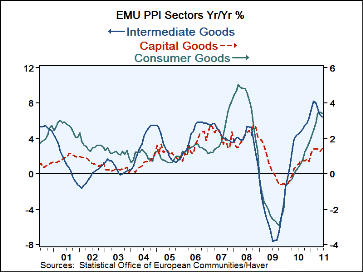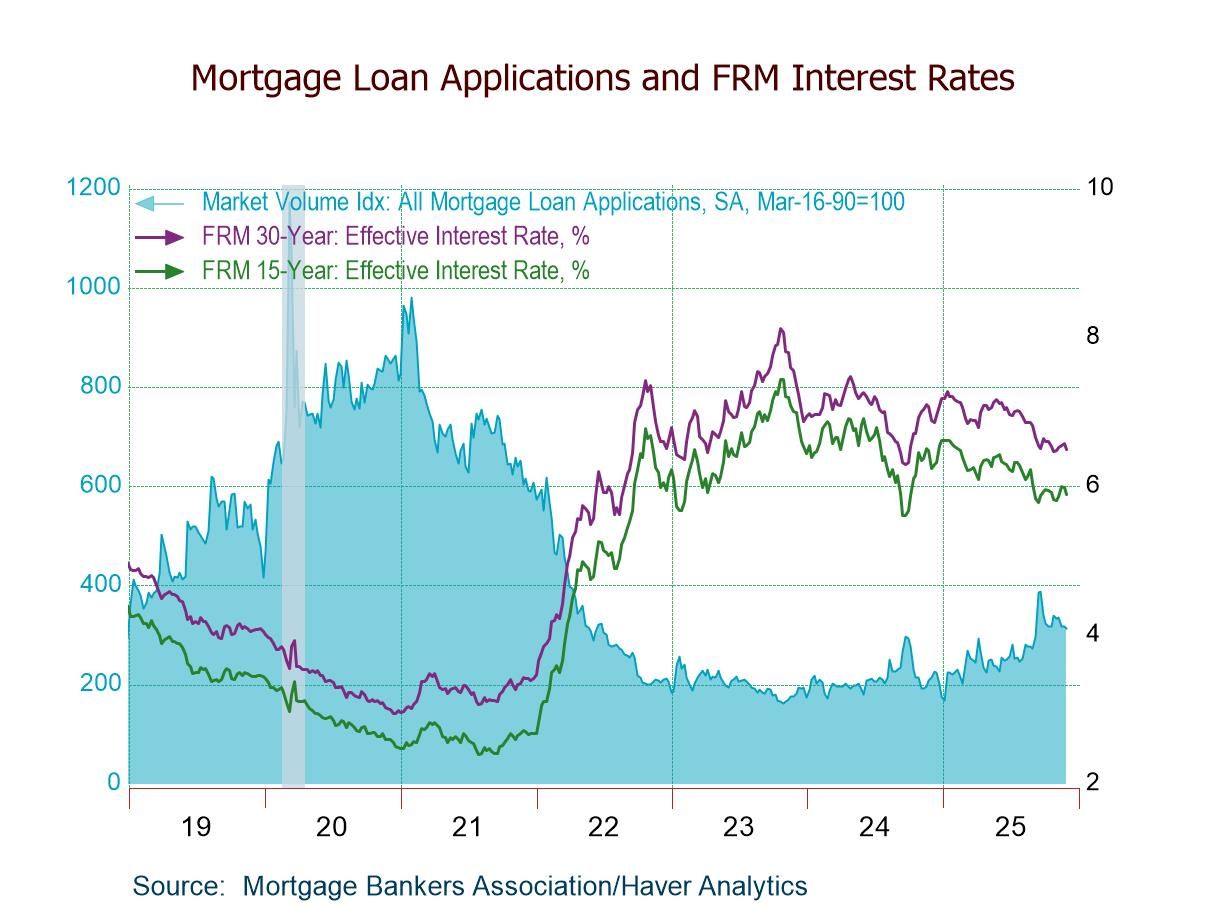 Global| Aug 02 2011
Global| Aug 02 2011Euro-Area Inflation Trends
Summary
The PPI for the Euro-Area fell by 0.3%, the second straight drop in a row. The PPI has been steadily decelerating, as energy prices has abated their rise. Both headline and core inflation rates across key Euro-Area member countries [...]
 The PPI for the Euro-Area fell by 0.3%, the second straight drop in a row. The PPI has been steadily decelerating,
as energy prices has abated their rise. Both headline and core inflation rates across key Euro-Area member countries
are fading, showing sequentially less pressure. Intermediate goods prices are falling as are manufacturing prices.
MFG prices are off quite sharply dropping at a 2.4% annual rate over three-months. Yet they are still rising 5.5%
year over year.
The PPI for the Euro-Area fell by 0.3%, the second straight drop in a row. The PPI has been steadily decelerating,
as energy prices has abated their rise. Both headline and core inflation rates across key Euro-Area member countries
are fading, showing sequentially less pressure. Intermediate goods prices are falling as are manufacturing prices.
MFG prices are off quite sharply dropping at a 2.4% annual rate over three-months. Yet they are still rising 5.5%
year over year.
But whatever good inflation trend has been set in the mix, it is being undermined as energy prices are proving stubborn and gold prices continue their assault on higher levels. But at the same time, while commodity prices pressures are not abating quite as much as might have been expected, the global economy seems to be undergoing a synchronous slowdown. The PMI indices in Europe have been declining steadily and rapidly over the last three-months in particular. In the US, the manufacturing and ‘services’ PMIs also have been engaged in some bumpy and, sometimes, exaggerated declines. The slack that is developing in the global economy has not yet seemed to have fully impacted the inflation forces. It is surprising that this slowdown has not taken a larger bite out of the uptrend for commodity prices. But it has not.
For the moment inflation trends are being damped. But commodity prices trends will continue to keep the monetary authorities wary. Producer prices are relatively more affected by commodity prices and they continue to overshoot the sort of standard that the ECB would apply to consumer prices.
| Euro-Area and UK PPI Trends | ||||||
|---|---|---|---|---|---|---|
| M/M | SAAR | |||||
| Euro-Area | Jun-11 | May-11 | 3Mo | 6Mo | Yr/Yr | Y/Y YrAgo |
| TotalxConstruct | -0.3% | -0.4% | 0.2% | 5.5% | 5.9% | 3.0% |
| Capital Gds | 0.3% | -0.1% | 1.7% | 2.4% | 1.4% | 0.4% |
| Consurmer Gds | 0.0% | 0.3% | 3.7% | 4.1% | 3.4% | 0.2% |
| Intermediate | -0.1% | -0.1% | 1.3% | 6.0% | 6.4% | 4.3% |
| MFG | -0.3% | -0.5% | -2.4% | 3.8% | 5.5% | 3.6% |
| Germany | ||||||
| Gy ExEnergy | 0.1% | 0.2% | 1.8% | 3.9% | 3.6% | 2.1% |
| France:Tot | ||||||
| Fr ExF&Energy | 0.1% | 0.2% | 2.6% | 4.7% | 3.5% | 1.5% |
| Italy | -0.1% | -0.7% | -3.7% | 4.1% | 5.3% | 3.9% |
| UK | 0.1% | -0.1% | 2.3% | 6.4% | 5.7% | 4.4% |
| Euro-Area Harmonized PPI ex construction | ||||||
Robert Brusca
AuthorMore in Author Profile »Robert A. Brusca is Chief Economist of Fact and Opinion Economics, a consulting firm he founded in Manhattan. He has been an economist on Wall Street for over 25 years. He has visited central banking and large institutional clients in over 30 countries in his career as an economist. Mr. Brusca was a Divisional Research Chief at the Federal Reserve Bank of NY (Chief of the International Financial markets Division), a Fed Watcher at Irving Trust and Chief Economist at Nikko Securities International. He is widely quoted and appears in various media. Mr. Brusca holds an MA and Ph.D. in economics from Michigan State University and a BA in Economics from the University of Michigan. His research pursues his strong interests in non aligned policy economics as well as international economics. FAO Economics’ research targets investors to assist them in making better investment decisions in stocks, bonds and in a variety of international assets. The company does not manage money and has no conflicts in giving economic advice.






